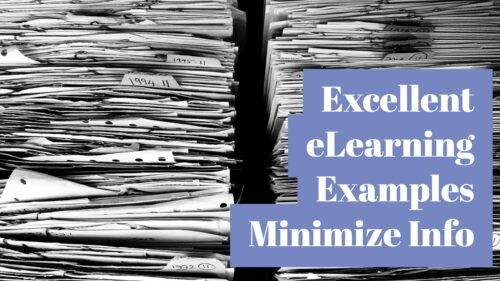Is There Too Much Info in Your e-Learning Course?
I usually start my posts with a short intro about the topic, to entice you into reading more. But today I’m going to admit it up front – this is less of an article and more a collection of my recent musings on how we should be using instructional design. Enjoy!
Exploring e-learning examples
Over the past 6 months I’ve been sending out weekly emails on a variety of topics that fascinate me about the world of e-learning.
One of my recent emails was to share one of my favorite examples of scenario-based training (the fact that it was a scenario is actually irrelevant to this story). You can see Cathy Moore’s evaluation of the same scenario in this excellent post.
This has led to replies from my subscribers to my email list with suggestions of other excellent examples of e-learning out there in the public domain that I should explore.
The Common Thread Amongst Excellent eLearning Examples
As I was looking through these examples, something struck me as a common theme throughout – the nature of the content being delivered was very high level. I.e. none of these powerful examples of e-learning were going too deeply into a subject (or if they were, as the learner I wasn’t forced into viewing it all).
So I started thinking about how we use e-learning in the workplace – and from an Instructional Design perspective, how we build courses.
Are we trying to include too much information? It is a common complaint to hear Instructional Designers mention that SME’s want to add all of the information into the course just in case the learner needs it. This is clearly a disrespectful way to value our learners time and focus!
As one of our presenters recently explained on one of our webinars on mobile learning, “successful learning in the workplace is no longer about delivering all of the information – it is about guiding the learner towards the information they need”.
Providing an Overview Rather Than Detail in Your eLearning
So the thing I’m getting at here is that rather than being so focused on including all of the relevant information in the content itself, perhaps we should be more focused on providing a high level overview of the key points, followed by some clear instruction on where to find more high quality, deep learning on the topics elsewhere.
That might be on public websites, learning management systems like Litmos, or other forums such as workplace discussions in Yammer or Slack. (Are you aware of how Slack is changing L&D?)
This would allow us to create content on a much broader scope of topics, delivering more value and wasting less of the learner’s time learning about topics that they may only need to understand on a macro level.
Covering Old Ground?
Maybe I’m covering old ground here, or maybe I’ve just lost sight of this within the courses I’ve been involved in building recently – but I’d be keen to hear your thoughts.
Do you find it challenging to limit the amount of detail going into each course?
Have you tried using e-learning to provide a high level of content with instruction on how to find detail elsewhere?






